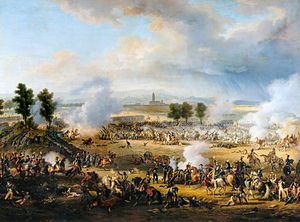
Back Batalla de Marengo AN معركة مارنجو Arabic مارنقو دؤیوشو AZB Битка при Маренго Bulgarian Emgann Marengo Breton Batalla de Marengo Catalan Bitva u Marenga Czech Slaget ved Marengo Danish Schlacht bei Marengo German Μάχη του Μαρένγκο Greek
| Battle of Marengo | |||||||
|---|---|---|---|---|---|---|---|
| Part of the Italian campaigns in the War of the Second Coalition | |||||||
 The Battle of Marengo, by Louis-François Lejeune | |||||||
| |||||||
| Belligerents | |||||||
|
|
| ||||||
| Commanders and leaders | |||||||
|
|
| ||||||
| Strength | |||||||
|
Originally: 22,000 men, 15 cannon Total: 28,000 men[3] | 30,000 men, 100 cannon | ||||||
| Casualties and losses | |||||||
|
1,100 killed 3,600 wounded 900 captured[4][5] |
6,000 killed or wounded 8,000 captured[4][6] | ||||||
Location within Europe | |||||||
The Battle of Marengo was fought on 14 June 1800 between French forces under the First Consul Napoleon Bonaparte and Austrian forces near the city of Alessandria, in Piedmont, Italy. Near the end of the day, the French overcame General Michael von Melas' surprise attack, drove the Austrians out of Italy and consolidated Bonaparte's political position in Paris as First Consul of France in the wake of his coup d'état the previous November.[7]
Surprised by the Austrian advance toward Genoa in mid-April 1800, Bonaparte hastily led his army over the Alps in mid-May and reached Milan on 2 June. After cutting Melas's line of communications by crossing the river Po and defeating Feldmarschallleutnant (FML) Peter Karl Ott von Bátorkéz at Montebello on 9 June, the French closed in on the Austrian Army, which had massed in Alessandria. Deceived by a local double agent, Bonaparte dispatched large forces to the north and the south, but the Austrians launched a surprise attack on 14 June against the main French army, under General Louis Alexandre Berthier.[8]
Initially, their two assaults across the Fontanone stream near Marengo village were repelled, and General Jean Lannes reinforced the French right. Bonaparte realized the true position and issued orders at 11:00 am to recall the detachment under Général de Division (GdD) Louis Desaix while he moved his reserve forward. On the Austrian left, Ott's column had taken Castel Ceriolo, and its advance guard moved south to attack Lannes' flank. Melas renewed the main assault, and the Austrians broke the central French position. By 2:30 pm, the French were withdrawing, and Austrian dragoons seized the Marengo farm.[8] Bonaparte had by then arrived with the reserve, but Berthier's troops began to fall back on the main vine belts. Knowing that Desaix was approaching, Bonaparte was anxious about a column of Ott's soldiers marching from the north and so he deployed his Consular Guard infantry to delay it. The French then withdrew steadily eastward toward San Giuliano Vecchio as the Austrians formed a column to follow them, as Ott also advanced in the northern sector.[8]
Desaix's arrival at around 5:30 pm stabilized the French position, as the 9th Light Infantry Regiment delayed the Austrian advance down the main road and the rest of the army reformed north of Cascina Grossa. As the pursuing Austrian troops arrived, a mix of musketry and artillery fire concealed the surprise attack of Général de Brigade (GdB) François Étienne de Kellermann’s cavalry, which threw the Austrian pursuit into disordered flight back into Alessandria, with about 14,000 killed, wounded or captured. The French casualties were considerably fewer but included Desaix. The whole French line chased after the Austrians to seal une victoire politique (a political victory) that secured Bonaparte's grip on power after the coup. It would be followed by a propaganda campaign that sought to rewrite the story of the battle three times during his rule.[8]
- ^ Brauer; William E. Wright (1 December 1990). Austria in the Age of the French Revolution: 1789–1815. Berghahn Books. p. 34. ISBN 978-1-57181-374-9. Retrieved 21 April 2013.
- ^ Holger Afflerbach; Hew Strachan (26 July 2012). How Fighting Ends: A History of Surrender. Oxford University Press. p. 215. ISBN 978-0-19-969362-7. Retrieved 17 April 2013.
- ^ Benoît, p. 117
- ^ a b Benoît, p. 122
- ^ Chandler, David G.. The Campaigns of Napoleon, New York, 1966, ISBN 0-02-523660-1, p. 296, gives: 25% total casualties.
- ^ Chandler, David G.. The Campaigns of Napoleon, New York, 1966, ISBN 0-02-523660-1, p. 296, gives: 15 colours, 40 guns, 8,000 captured and 6,000 killed. Asprey, Robert. The Rise of Napoleon Bonaparte, Basic Books, 2001, ISBN 0-465-04881-1, p. 387, gives: 6,000 killed or wounded and another 6,000 captured; 15 flags, 40 cannon.
- ^ Hollins, Encyclopedia, pp. 605–606
- ^ a b c d Hollins, Encyclopedia, p. 606
© MMXXIII Rich X Search. We shall prevail. All rights reserved. Rich X Search

